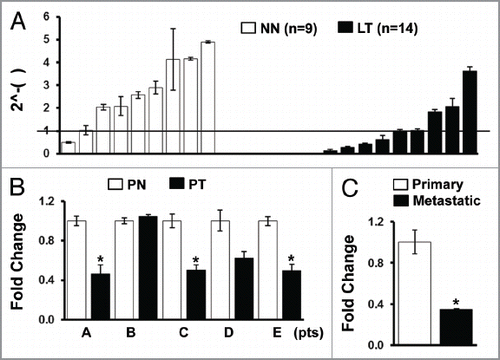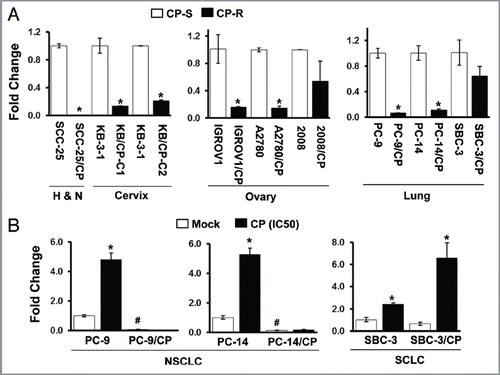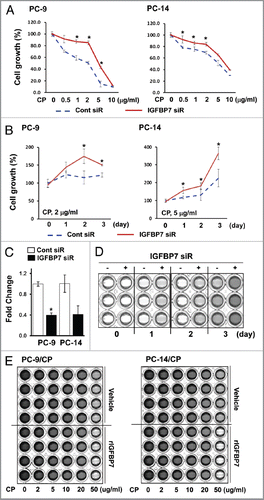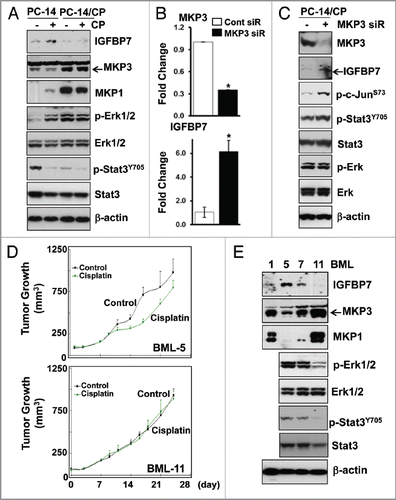Figures & data
Figure 1 IGFBP7 expression in normal and tumor lung. IGFBP7 expression was examined in cDNAs prepared from patients with lung cancer (LT) and without cancer (NN) (A), in pairs of normal and tumor cDNAs from five lung cancer patients (B), and in primary and metastatic lung tumor cDNAs from a patient with metastatic lung cancer (C) by qRT-PCR. 2^-(), expression of IGFBP7 relative to β-actin calculated based on the threshold cycle (Ct) as 2−ΔCt (ΔCt = Ct,IGFBP7 − Ct,β-actin). Experiments were done in duplicate, and values indicate means ± SD *p < 0.05 in t-test.

Figure 2 Downregulation of IGFBP7 in cisplatin resistant cell lines. (A) Expression of IGFBP7 was compared between the parental, cisplatin-sensitive (CP-S) and isogenic, cisplatin-resistant (CP-R) cell lines by qRT-PCR. H and N, cells derived from head and neck cancer. (B) Cells were treated with cisplatin for 48 h and qRT-PCR was performed. NSCLC, non-small cell lung cancer; SCLC, small cell lung cancer. Experiments were done in duplicate, and values indicate means ± SD *p < 0.05 in t-test.

Figure 3 Increased resistance to cisplatin by IGFBP7 knock-down in the parental cell lines. (A) PC-9 and PC-14 cells were transfected with non-targeting control (Cont siR) or IGFBP7 siRNA (IGFBP7 siR) for 24 h, and then treated with cisplatin for 48 h. The MTT assay was performed to assess cellular sensitivity to cisplatin. (B) Cells were treated with cisplatin at IC50 for 3 d after transfection with non-targeting control or IGFBP7 siRNA. Cell growth was assessed by the MTT assay. (C) IGFBP7 knock-down was confirmed by qRT-PCR. Experiments were done in duplicate, and values indicate means ± SD *p < 0.05 in t-test. Pictures of PC-14 (D), PC-9/CP and PC-14/CP cells (E) on tissue culture plates were taken after DMSO was added to dissolve MTT crystals. Growth curves of PC-9/CP and PC-14/CP cells after rIGFBP7 treatment is shown in Figure S2.

Figure 4 Decreased IGFBP7 expression in cisplatin-resistant NSCLC. (A) Whole protein lysates were extracted from PC-14 and PC-14/CP cells with or without treatment with cisplatin (5 µg/ml), and immunoblot analysis was performed with the indicated antibodies. The PC-14/CP cells were transfected with non-targeting control or MKP siRNA for 48 h, and qRT-PCR (B) and immunoblot (C) analyses were performed. Experiments were done in duplicate, and values indicate means ± SD *p < 0.05 in t-test. (D) Tumor growth was monitored for 25 d after cisplatin injection in nude mice bearing the human NSCLC xenografts (1.5 mg/Kg, i.p.), and tumor volume was calculated. (E) Whole protein lysates were extracted from human lung xenografts (BML-1, -5, -7 and -11), and immunoblot analysis was performed. Erk and Stat3 levels were not examined in BML-1 due to insufficient quantity of protein.
